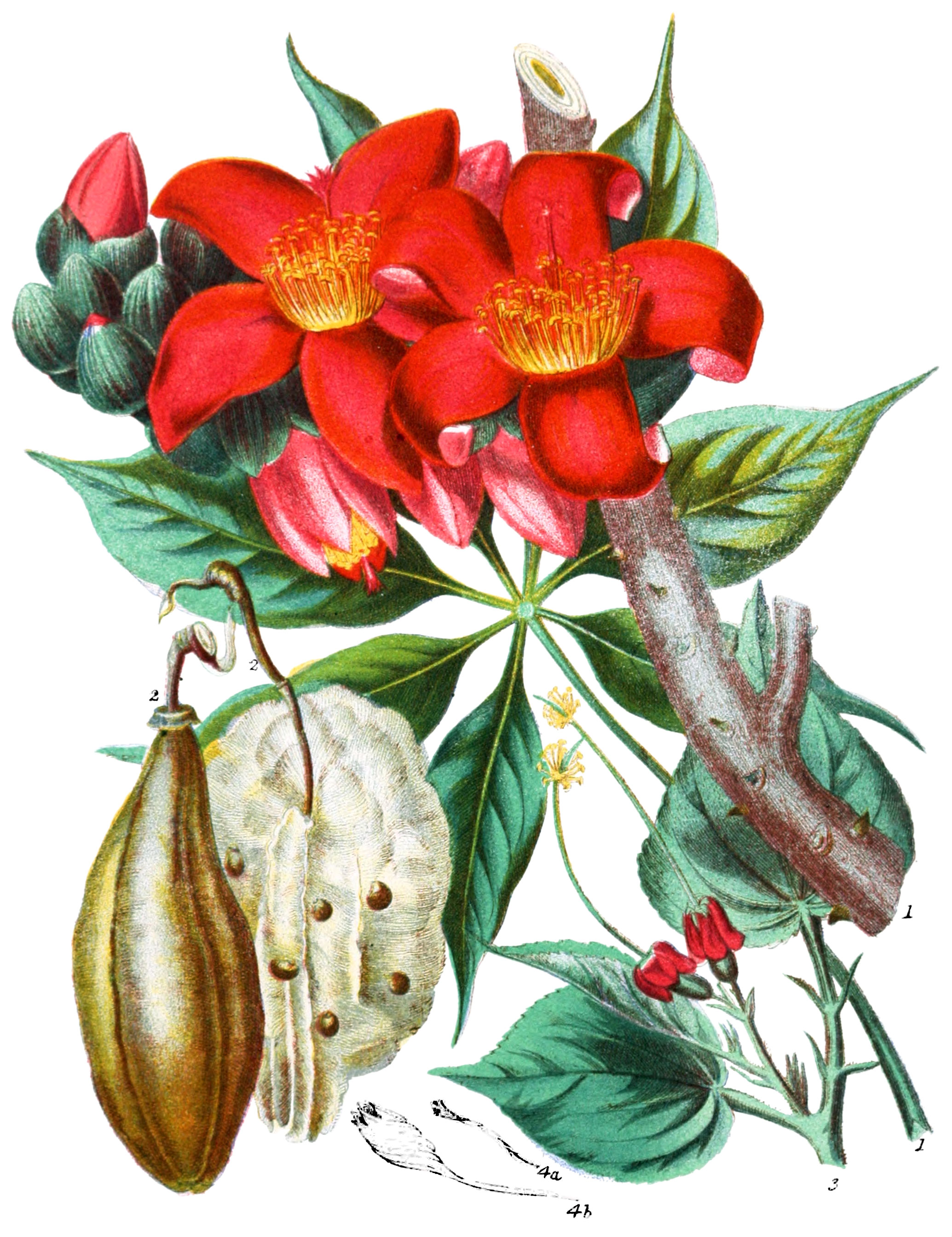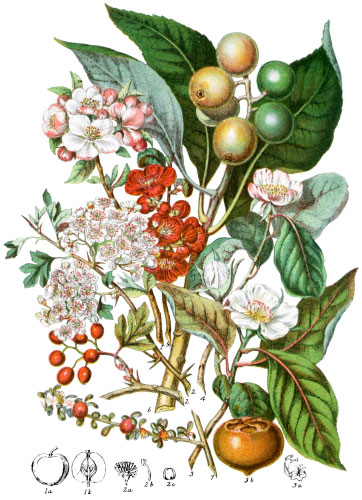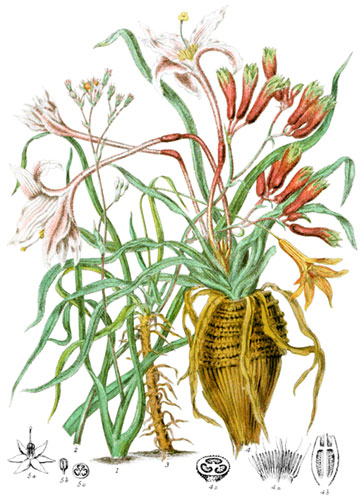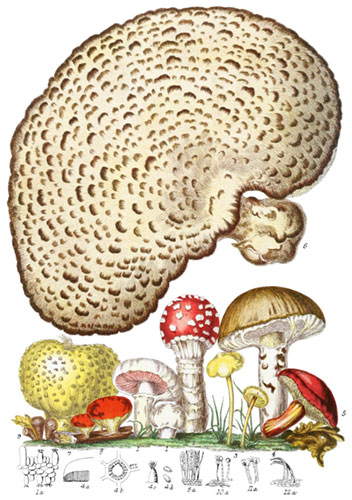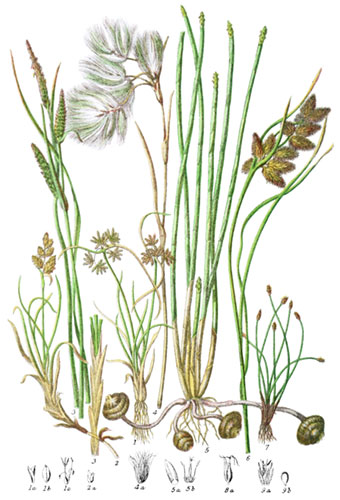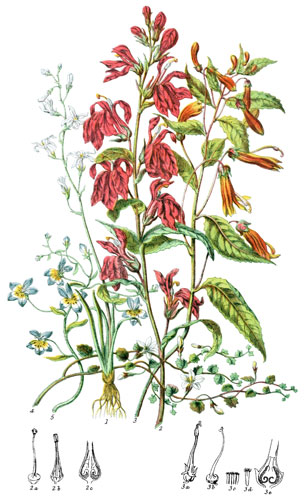Key characteristics
Large trees or shrubs, sometimes clothed with stellate hairs; the leaves are alternate, simple, or compound, some of a digitate form, often toothed at the edges, with free deciduous stipules. The flowers are variable, regular or irregular, in some cases not having both stamens and pistils. The calyx has five sepals in valves, not imbricated, and is either naked or surrounded with an involucre more or less united at the base. The petals are five, or wanting, convolute in the bud state. The stamens are numerous, united in sets in various ways; the anthers are two-celled, turned outwards, and in some species have various turnings and winding passages. The pistil consists of five, rarely three carpels, either separate or cohering into a single ovary, often placed on a column-like axis; the styles are equal in number to the carpels, distinct or united. The fruit is a capsule with three or five cells, as in Bombax; or a fleshy drupe, as in Myrodia; or a berry, or a pod bursting long before the ripening of the seeds as in Herculia. The seeds ovate or angular, sometimes involved in silky cotton.
This Order has affinity with Marlvaceæ both in structure and properties. It is chiefly remarkable for the abundant mucilage contained in the plants, and for the profusion of silky cotton in the seed-vessels of Bombax and others.
Select plants in this order
Not all plants listed are illustrated and not all plants illustrated are listed.
- Bombax is more to be admired for its noble aspect than valued for its utility, although it is of some service in he countries where it is indigenous. The down of the capsules is useless for spinning, as there exists no adhesion between the hairs; it has, however, been employed in South America for hats, and is occasionally used by the poor natives fo stuffing cushions, but is considered unwholesome for beds.
- Bombax heptaphyllum (1) is one of the largest of East Indian trees, and is found in various districts throughout the country, growing to a greater size near the hills than elsewhere, often attaining 100 feet in height. It begins to blossom about the end of winter, before the leaves come forth, and has a splendid appearance when covered with its bright red flowers. The trunk is straight, covered with many sharp conical prickles; the bark is rough, ash-coloured on the outside, the branches grow horizontally, and are also armed with prickles. The wood is white, light and spongy, fit for few purposes except to make floating rafts; in India the cotton is put between quilted cloths.
- B. pendandrum (2)* abounds in Antigua and other West Indian Islands; the seeds are eaten, and the soft brown cotton is used by the natives.
- B. ceiba is an immense tree in South America and the East Indies; the spiny trunk spreads out into enormous buttresses at the base, it is often hollowed out into a canoe of twenty-five tons burden, carrying from fifteen to twenty hongsheads of sugar. Columbus found one of these canoes on his first discovery of Cuba, which was capable of containing 150 men. When the tree decays it becomes food for the Macaca beetle, which is fried and eaten as a delicacy by West Indian epicures.
- In the mass of luxuriant vegetation which covers the tract of country bounding the Great Desert of Africa on the south, the tree most likely to attract the attention of a traveller is the enormous Adansonia digitata, the Baobab or Calabash tree; this is supposed to be the largest production of the vegetable kingdom, and to be of the greatest longevity. Adanson measured some of the banks of the Senegal more than seventy feet in circumference, the trunks were about fifteen feet high before branching, the immense horizontal branches were fifty feet in length, descending by their weight to the ground at their extremities; the portion of the roots above the ground was upwards of 100 feet long; the whole tree forms an hemispherical body sometimes as much as 150 feet in diameter. The oblong fruit is about ten inches long, downy on the exterior of the brown rind, the interior is filled with a white farinaceous pulp containing the seeds; it has a pleasant acid flavour, and is much eaten by the Africans, who also prepare a medicine and a kind of soap from it. The rind of the fruit serves for useful vessels, the bark furnishes a coarse fibrous thread, of which they make ropes and cloth; the young leaves are eaten in times of scarcity, the larger are used to thatch their huts.
- Adansonia was long ago introduced into India; large trees exist at Allahabad, and other places in India and in Ceylon.
- Herculia Tragacantha of Sierra Leone yields a famous gum; the seeds of this and other species contain an oil that might be used for lamps.
- Helicteres (4)† is remarkable for the twisted seed-vessel; although chiefly natives of S. America, H. Isora and a few other species are found in India and China.
- Cheirostemon platanoides, the singular Hand-plant of Mexico, has no petals, but a large leathery calyx, from the centre of which arises a column of five curved anthers, and a curved style, though to resemble a hand or claw.
- Durio Zibethinus is much cultivated in the Isles of the Indian Archipelago for its fruit.
Locations
Nearly all the plants of this tribe are natives of the Tropics, where they are extensively dispersed; Bombax abounds in America and India, Adansonia and Herculia belong chiefly to Africa and India, Helicteres and its immediate allies seem to be unknown in Africa, but a few species extend beyond the usual limits of the Order, as far as Tasmania and New Zealand: none belong to Europe.
Legend
- Bombax heptaphyllum, Silk-cotton Tree. East Indies.
- Bombax pentandum. West Indies.*
- Seed-vessels.*
- Helicteres verbascifolia, Mullein-leaved Screw-tree. Brazil.
- Helicteres brevispira.†
- Pistil.
- Seed-vessel.
- *2a was labeled as 2 in the original illustration.
- †4 was not in the original illustration.
Explore more
Posters
Decorate your walls with colorful detailed posters based on Elizabeth Twining’s beautiful two-volume set from 1868.
Puzzles
Challenge yourself or someone else to assemble a puzzle of all 160 botanical illustrations.
